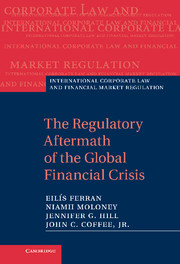Book contents
- Frontmatter
- Contents
- Foreword
- Notes on Contributors
- Acknowledgements
- Table of cases
- Table of legislation
- 1 Crisis-driven regulatory reform: where in the world is the EU going?*
- 2 The legacy effects of the financial crisis on regulatory design in the EU
- 3 Why did Australia fare so well in the global financial crisis?
- 4 The political economy of Dodd-Frank: Why financial reform tends to be frustrated and systemic risk perpetuated
- Index
- References
4 - The political economy of Dodd-Frank: Why financial reform tends to be frustrated and systemic risk perpetuated
Published online by Cambridge University Press: 05 December 2012
- Frontmatter
- Contents
- Foreword
- Notes on Contributors
- Acknowledgements
- Table of cases
- Table of legislation
- 1 Crisis-driven regulatory reform: where in the world is the EU going?*
- 2 The legacy effects of the financial crisis on regulatory design in the EU
- 3 Why did Australia fare so well in the global financial crisis?
- 4 The political economy of Dodd-Frank: Why financial reform tends to be frustrated and systemic risk perpetuated
- Index
- References
Summary
The following chapter is reprinted in its entirely from its original publication as an article in the Cornell Law Review, 97 Cornell L. Rev. __ (forthcoming 2012)
Introduction
A good crisis should never go to waste. In the world of financial regulation, experience has shown – since at least the time of the South Sea Bubble three hundred years ago – that only after a catastrophic market collapse can legislators and regulators overcome the resistance of the financial community and adopt comprehensive “reform” legislation. US financial history both confirms and conforms to this broader generalization. The Securities Act of 1933 and the Securities Exchange Act of 1934 were the product of the 1929 stock-market crash and the Great Depression, and their enactment had to await the inauguration of President Franklin Roosevelt in 1933. The decisive event fueling public indignation and shaping these statutes was the Pecora Hearings before the Senate Banking and Currency Committee, which continued from 1932 to 1934. The Sarbanes-Oxley Act (“SOX”) was enacted, possibly in some haste, in 2002, following the collapse of Enron in late 2001 and WorldCom in 2002 and an accelerating crescendo of financial statement restatements by other public corporations. Finally, the Dodd-Frank Act, enacted in 2010, followed an even greater financial collapse, one that threatened financial institutions on a global scale and brought the problem of systemic risk to the attention of a public already infuriated at financial institutions (and their highly compensated investment bankers) being bailed out at taxpayer expense. In each of these episodes, abundant evidence of financial chicanery and fraud was uncovered, and the public was outraged and revulsed. Not surprisingly, in each of these cases, the comprehensive reform legislation that followed in the wake of the market collapse showed hints of the public's desire for retribution. All that is different this time is that the crisis may be wasted – as hereinafter explained.
- Type
- Chapter
- Information
- The Regulatory Aftermath of the Global Financial Crisis , pp. 301 - 372Publisher: Cambridge University PressPrint publication year: 2012
References
- 13
- Cited by



